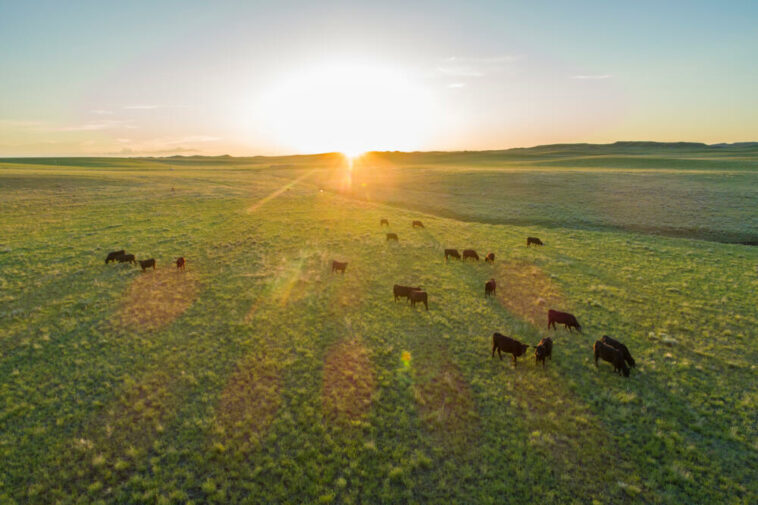Future farming can have a variety of meanings, including an innovative farming technique or more personally, farming for future generations. For many landowners, the latter can inspire big changes on their land. Planting native grasses and forbs can offer a beauty that is unique to our state while offering a new use for land that is difficult to manage. Looking out into a prairie, one can enjoy a sea of grasses blowing in the wind displaying a range of reds, oranges, blues, and purples; however, this is often a memory for most, offering a bit of nostalgia from decades ago. Today, less than 1% of tallgrass native prairie remains in North Dakota, and our future generations might miss the opportunity to enjoy these scenic landscapes if we don’t begin to reseed North Dakota’s grasslands. It’s easy to think grasslands are dull and destitute, but they serve many necessary purposes for soil health, water filtration, and habitat for the many birds, mammals, and insects that depend on them for survival. Taking marginal cropland and turning it into grasslands will greatly serve future generations, not only for their enjoyment of the scenic views, but also for the environmental impacts sustained.
In North Dakota producers and landowners interested in planting perennial grasses and forbs on their land can do so in a joint effort with conservation allies. An exciting new opportunity for landowners has emerged in North Dakota, the Conservation Forage Program (CFP) with Audubon Dakota and partners across the state. The Conservation Forage Program provides financial and technical assistance to plant perennial grasses and forbs to increase forage availability for livestock producers and address natural resource concerns. Doing so will create profitable grazing land or hayland on marginal acres, thus adding value to their land. This project is made possible by the North Dakota Industrial Commission Outdoor Heritage Fund, which awarded a $6.9 million grant, the largest awarded by the Commission, aimed at grassland expansion. Audubon Dakota advocates for conservation efforts with the greatest benefit for bird conservation. CFP is designed for North Dakota’s producers to plant marginal croplands back to grasslands to improve forage availability and quality for grassland birds while increasing their habitat across the state. Enrolling land in this program gets producers one step closer to creating a landscape that future generations can enjoy.
“CFP is an excellent example of how conservation, agriculture and producer partners can indeed come together for a common goal, in this case to improve forage availability and quality across the state. We are so fortunate to have the Outdoor Heritage Fund’s and partner support to make this innovative concept a reality,” said Sarah Hewitt, Conservation Programs Manager for Audubon Dakota.
The Conservation Forage Program will lead the restoration of grassland habitat across North Dakota, not only for grassland bird species, but also for native pollinators, like monarch butterflies. Protecting these wildlife species offers a reward of wonderment and joy for families that appreciate the prairie. Developing land management techniques across private lands over a ten-year project period, landowners enrolled will improve forage availability and quality, wildlife habitat, and soil health. By planting perennial cover, producers improve soil health which can provide better water filtration, microbial diversity, soil carbon storage, and increase the supply of nutrients to plants. Perennial cover also provides habitat for wildlife including grouse, pheasants, and songbirds. This helps conservation efforts by improving habitat and forage quality for native wildlife and species to survive. Integrating grazing practices will further increase the landowner’s earning potential on the restored land through the value of the grazed forage. This provides an opportunity to increase land value especially for cropland that is environmentally sensitive and could be better utilized.
“The biggest benefit of CFP, when compared to similar programs, is that the CFP offers increased management flexibility beyond year three for producers to graze, hay, and overall manage their land,” said Josh Lefers, Working Lands Program Manager for Audubon Dakota.
Once seen as non-essential objective for many, conservation practices are now viewed as beneficial opportunity. While various programs exist to motivate landowners to adopt conservation practices, it can be expensive and time-consuming, and some programs are too competitive or have strict guidelines and restrictions prohibiting some from participating.
CFP is a pilot program that provides the opportunity for interested landowners to convert cropland into perennial forage. Unlike similar programs, CFP encourages application from historically underserved farmers and ranchers in connection to the Agriculture Improvement Act of 2018 (2018 Farm Bill). Additionally, CFP has no minimum land requirement of land ownership, making this program a unique opportunity for new landowners often overlooked.
The Conservation Forage Program provides financial assistance to growers to offset deferred income and assist with seed costs and other aspects of restoration management, including fencing and water infrastructure. Audubon Dakota and partners provide a technical assistance partner and one-on-on planning to ensure success. Producers enrolled will work with a program partner to develop a restoration management plan that will cover site preparation, seed composition, seeding rate, timing, and post-planting management. After implementation, participants will actively manage their land including weed control, haying, resting, and grazing. Developed and backed by Audubon Dakota, U.S. Fish and Wildlife Service, Delta Waterfowl, North Dakota Game and Fish, North Dakota Wildlife Federation, Ducks Unlimited, Natural Resources Conservation Service, the North Dakota Natural Resources Trust, and the North Dakota Association of Soil Conservation Districts. Conservation is a team effort, and the expertise from each organization allows for project selection and assistance at a broader reach.
“What makes the CFP unique is the ability for the producer to receive rental payments as the land is transitioned from marginal cropland to working grasslands,” said Kevin Kading, Private Lands Section Leader with North Dakota Game and Fish Department. “Unlike many similar programs, the producer receives an income on those acres during the critical time of establishment. Once the grass is fully established, the producer can utilize those grasslands for grazing. This is an appealing feature of the program, since through the life of the agreement, the producer is able to generate income off the property.”
North America’s grasslands are among the most imperiled ecosystems in the world. In North Dakota, restoring land back to native prairie not only contributes to conservation by creating natural habitats for native animals, birds, and insects, it reduces erosion and runoff, improving water filtration. Grassland bird species that rely on this habitat are among the most endangered group of birds in the United States. Since 1966, populations have declined more than 40 percent and for some species up to 80%. The majority of grasslands in North Dakota are on private lands, making private landowners major stewards of North American grasslands that play a key part in conservation collaboration to restore habitats for native bird species. The next enrollment period for the Conservation Forage Program opened November 15 with the goal of enrolling 18,000 acres.
The benefit of programs like CFP can be measured economically, but what can’t be measured is the excitement and appreciation that generations to come will experience while enjoying the native prairie of their homeland. It’s priceless.
The National Audubon Society protects birds and the places they need, today and tomorrow. Audubon works throughout the Americas using science, advocacy, education, and on-the-ground conservation. State programs, nature centers, chapters, and partners give Audubon an unparalleled wingspan that reaches millions of people each year to inform, inspire, and unite diverse communities in conservation action.
A nonprofit conservation organization since 1905, Audubon believes in a world in which people and wildlife thrive. Audubon Dakota is the North and South Dakota state office of the National Audubon Society. Where birds thrive, people prosper -Audubon Dakota aims to connect with communities throughout North and South Dakota to demonstrate the importance of protecting and restoring native habitats for our bird species.
Conservation Forage Program Fast Facts
Conservation Forage Program Goal:
Audubon Dakota’s Conservation Forage Program (CFP) is designed for North Dakota’s producers to restore marginal croplands back to grasslands to improve forage availability and quality for grassland birds. The CFP aims to accelerate grassland restoration and recover overall soil health and grassland bird habitat across the state. Learn more: Dakota.audubon.org
| Term Agreement | 10 Year |
| Payments | 3 Year Established Payments – Based on the most recently published NASS rate for the year enrolled for your county |
| Cost Share | 60% forage seed mix cost share based of EQUIP Rates for 2020 |
| 50% grazing infrastructure cost share (perimeter, water, infrastructure) | |
| Eligibility | Land is in North Dakota Land is currently cropland. Landowner has authority to plant perennial forages – Land capability classes between a score of 4 through 8 on at least 25% of the priority given to land that meets that classification – Cannot be currently enrolled in CRP |




